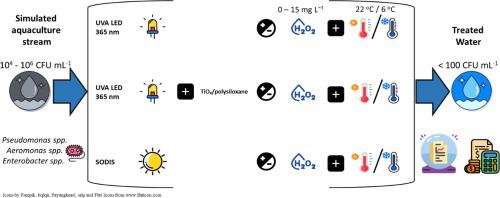Solar Energy ( IF 6.0 ) Pub Date : 2021-09-20 , DOI: 10.1016/j.solener.2021.09.029 Elena Villar-Navarro , Irina Levchuk , Juan José Rueda-Márquez , Tomáš Homola , Miguel Ángel Moriñigo , Riku Vahala , Manuel Manzano

|
In this work the effect of water temperature (6 ± 1 °C and 22 ± 1 °C) on inactivation of bacteria (104 –106 CFU mL−1; Pseudomonas spp., Aeromonas spp. and Enterobacter spp.) in simulated aquaculture streams (SAS) using UVA based advanced oxidation processes (AOP) (H2O2-assisted UVA; photocatalysis; H2O2-assisted photocatalysis) and solar driven AOPs (H2O2-assisted solar disinfection, SODIS) was studied. Efficiency at 22 °C in terms of inactivation rate was higher using H2O2-assisted photocatalysis (H2O2/UVA-TiO2/polysiloxane) > H2O2-assisted UVA disinfection (UVA/H2O2 – 10 mg L-1) > photocatalysis (UVA-TiO2/polysiloxane) > UVA disinfection. At low temperature (6 °C) the inactivation rate increased with SODIS/H2O2 > SODIS > H2O2-assisted UVA disinfection (UVA/H2O2 – 10 mg L-1) > H2O2-assisted photocatalysis (H2O2/UVA-TiO2/polysiloxane) > photocatalysis (UVA-TiO2/polysiloxane). The main results indicate that the inactivation rates increased when hydrogen peroxide (10 mg L-1) was used during H2O2-assisted UVA disinfection and photocatalysis. In addition, exposure of SAS to hydrogen peroxide for 24 h (in absence of light) at room temperature decreased the subsequent exposure UVA irradiation dose by almost four times.
Drastic increase of inactivation rate was observed at low water temperature (6 ± 1 °C) when UVA- and solar-based AOPs were employed compared to 22 ± 1 °C. The treatment with SODIS proved to be more effective in Finland than in Spain. The effect of the low temperature (6 ± 1 °C) was proposed as a critical factor during UVA disinfection (UVA/H2O2 and photocatalysis) that can increase the disinfection rate constant (kmax) by 1.3–5.2 times, leading to a reduction of the treatment costs (€ m−3) by 1.3–3.3 times. The mechanism of observed enhanced disinfection at low water temperature (6 ± 1 °C) when natural solar light and UVA are employed as irradiation sources for UVA/H2O2 and photocatalytic bacteria inactivation was proposed. No regrowth was observed in case of H2O2-assisted AOPs.
中文翻译:

使用先进的基于 UVA 和太阳能的氧化方法在低温下灭活模拟水产养殖溪流细菌
在这项工作中,水温(6 ± 1 °C 和 22 ± 1 °C)对模拟细菌(10 4 –10 6 CFU mL -1;假单胞菌属、气单胞菌属和肠杆菌属)灭活的影响使用基于 UVA 的高级氧化工艺 (AOP)(H 2 O 2辅助 UVA;光催化;H 2 O 2辅助光催化)和太阳能驱动的AOP (H 2 O 2辅助太阳能消毒,SODIS)的水产养殖流(SAS )是学习了。使用 H 2 O 2在 22 °C 下的灭活率效率更高-辅助光催化(H 2 O 2 /UVA-TiO 2 /聚硅氧烷)> H 2 O 2 -辅助UVA消毒(UVA/H 2 O 2 – 10 mg L -1)>光催化(UVA-TiO 2 /聚硅氧烷)>紫外线消毒。在低温 (6 °C) 下,灭活率随 SODIS/H 2 O 2 > SODIS > H 2 O 2辅助 UVA 消毒(UVA/H 2 O 2 – 10 mg L -1)> H 2 O 2 - 增加辅助光催化(H 2 O2 /UVA-TiO 2 /聚硅氧烷)>光催化(UVA-TiO 2 /聚硅氧烷)。主要结果表明,在 H 2 O 2辅助的 UVA 消毒和光催化过程中使用过氧化氢 (10 mg L -1 )时灭活率增加。此外,在室温下将 SAS 暴露于过氧化氢 24 小时(在没有光的情况下)将随后暴露的 UVA 照射剂量降低了近四倍。
与 22 ± 1 °C 相比,当使用基于 UVA 和太阳能的 AOP 时,在低水温 (6 ± 1 °C) 下观察到灭活率急剧增加。SODIS 治疗在芬兰被证明比在西班牙更有效。低温 (6 ± 1 °C) 的影响被认为是 UVA 消毒(UVA/H 2 O 2和光催化)过程中的一个关键因素,可以将消毒速率常数 (k max ) 提高 1.3–5.2 倍,导致将处理成本(€ m -3)降低 1.3-3.3 倍。使用自然太阳光和 UVA 作为 UVA/H 2 O 2 的辐照源时,观察到的在低水温 (6 ± 1 °C) 下增强消毒的机制并提出了光催化细菌灭活。在 H 2 O 2辅助的 AOP 的情况下没有观察到再生长。











































 京公网安备 11010802027423号
京公网安备 11010802027423号